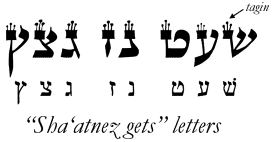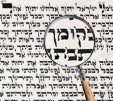|
Hebrew Consonants
There are 22 letters of the Hebrew alphabet, with five letters having additional "final forms" when they appear at the end of a word. There are no capital letters in Hebrew.

Hebrew Vowels
Hebrew is normally written without vowel letters (though four letters: "Aleph," "Hey," "Vav," and "Yod" are also used as vowels in modern Hebrew today). Today, vowel marks are used to facilitate learning the language:

Read Right-to-Left
Hebrew is written and read from right to left, rather than left to right as in English. When you read a Hebrew book, you open the rightmost page and flip pages until you get to the leftmost page (just the opposite of an English book).

Letter Styles
Modern Hebrew uses square script for printed materials (such as books, newspapers, road signs, etc.) and cursive script for handwriting. For sacred writings such as the Torah scroll, a type of calligraphy is used. Samples are given below:
Block Text
Commonly seen in Hebrew books and newspapers. It is referred to as block print or sometimes Assyrian text.

Cursive Script
There is another style used for handwriting, in much the same way that cursive is used for the Roman (English) alphabet.

STA"M Calligraphy
For sacred documents, such as Torah scrolls or the scrolls inside tefillin and mezuzot, there is a special writing style with "crowns" (crows-foot-like marks coming up from the upper points called tagin) on many of the letters. This style of writing is known as STA"M (an abbreviation for "Sifrei Torah, Tefillin and Mezuzot," which is where you will encounter that style of writing:

Note that STA"M calligraphy itself has three major styles: Bet Yosef, Bet Ari, and Sephardi. Each of these styles has peculiarities regarding certain letter designs. For more information, consult a certified sofer STA'M or good book on Hebrew calligraphy.
Siddur Script
Another form of calligraphy is used in some Siddurim, or Jewish prayerbooks. This style of script is also found in ketubah (marriage contracts) and other documents of religious character such as birth certificates, invitations etc:

Rashi Script
Another script style is used in certain texts to distinguish the body of the text from commentary upon the text. This style is known as Rashi Script, in honor of Rashi, one of the greatest commentators on the Torah and the Talmud:

Transliterations
The process of writing Hebrew words in the English alphabet is known as "transliteration" and is as much an art as a science. On this web site I have attempted to follow a consistent transliteration scheme (letters, vowels).

Pronunciations
Ashkenazi Jews (those of Eastern European descent) tend to pronounce the alphabet differently than Sephardic Jews (those of Spain, Northern Africa, and Israel). On this site we will use the Sephardic pronunciation since it is the one used in the land of Israel.
Ancient Hebrew
Like other ancient writing systems, the Hebrew alphabet originally was written using a pictographic script:

The earliest Hebrew script (sometimes called Paleo-Hebrew) resembled the ancient Phoenician alphabet. Examples can be found on coins and clay fragments (called ostraca). Later, this script was replaced by the Aramaic alphabet (called Ketav Ashuri) by Ezra the scribe sometime during the Babylonian exile. Today, both the Torah and newspapers use modernized renditions of this same script, though everyday correspondence is written using Hebrew cursive.

Crowning letters
In some Torah Scrolls, eight Hebrew letters are given special adornment by attaching three "tagin" or crownlets to them. Collectively these letters are sometimes called "sha'atnezgets" letters. Some people have said that these crownlets are the "tittles" referred to by Jesus in Matthew 5:18, although it is unclear that the tagin were in use at the time of the Lord Jesus. It is more likely that the "tittle" refers to the "kots" or "thorn" that projects from a letter.

Hebrew Letters in the Magen David
The Star of David is called magen David (the shield of David). A fascinating coincidence of the star is that it appears to "encode" the shape of each of the 22 Hebrew alphabet characters:

Note: The last two letters (leftmost bottom) are called final letters.
|







